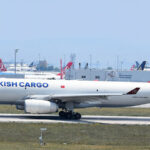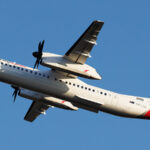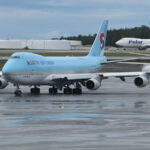Despite the fact that commercial cargo was carried aboard the first scheduled flight on the heels of World War I, and that the first all-cargo service was activated in 1926, air cargo—as the industry we know today— unfolded only after 1945. It took the horrors and global exigencies of a world war to open wide the gates of perception and expectation of a new industry-to-be.
The spark was created by the fabulous cargo-carrying exploits of the Air Transport Command and Naval Transport Service. Thousands of veterans returned to homes in the United States and in Europe, inspired by the new possibilities created by improving aviation technology. Many sought jobs associated with flying cargo, planting the seeds for dozens of airlines, forwarders and other companies that would paint the world’s air transport picture for decades to come.
The most dramatic culmination of this war-born spirit of enterprise was mirrored in the upsurge of so-called GI airlines, or nonskeds.
Many of these veteran-owned and -operated airlines (often no more than one or two war-surplus planes purchased at bargain prices) opted for cargo exclusively. From the colorful trading posts of China to garages in the new bedroom communities of the just-forming suburban United States, young entrepreneuers with the aroma of military jet fuel still clinging to their clothing started businesses with borrowed money and big dreams.
In nearly every case, however, their zeal exceeded the hard reality of the airline business; nudged by the tough competitive stance of the traditional airlines, they eventually faded from the scene.
Only a handful survived, notably among them Flying Tiger Line and Seaboard World Airlines. But the brief flurry of non-scheduled competition hastened the scheduled carriers’ interest and mounting investment in cargo, creating an industry that would ring the globe and forever change world commerce.
The early post-World War II era marked the fast-widening divide between small package/air express traffic, a staple of the scheduled domestic operators, and air freight/bulk shipments. With increasing frequency, United States and foreign-based airlines advertised their cargo capabilities.
It was a time when transport speed was the primary message to the shipping public. It was also a time when surface freight forwarders, domestic and international, hurriedly established air freight departments, and IATA-approved cargo agents mushroomed.
With the field largely theirs to control, the American airlines were less than ecstatic over the proliferation of forwarders, however. The airlines opposed them in several proceedings before the Civil Aeronautics Board. It took some years of heated battle in Washington before the forwarders were granted certification.
But the CAB eventually identified airlines and forwarders officially as direct and indirect air carriers, respectively. The terms live today at the Federal Aviation Administration.
Before 1945, and even for some time after, air freight dealing techniques were primitive. With few exceptions, cargoes were composed of emergency or other time-sensitive shipments. Then came the total cost concept (TCC). A Harvard physical distribution study mostly underwritten by Emery Air Freight, it clearly demonstrated the positive economic impact of speed on shipping costs and on marketing and distribution objectives. It set the foundation to drastically reduce the gap between high air transport and low surface transport rates—and in some instances proved that air could be more economical than lower-cost transport.
The airlines and major forwarders happily seized on the study—not as a serious developmental tool to be used by sales personnel thoroughly equipped to communicate its methodology to the shipping public, but instead as the latest promotional gimmick. Carriers told shippers that their one-on-one analyses were too costly and conversions meager. Instead, the airlines printed and distributed handsome do-it-yourselves forms. Fill in the figures and do your own arithmetic, and then ship with us.
In time, the campaign ran its futile course and disappeared. It took another generation for the TCC principle to become firmly embedded in logistics activity, pushed along by the academic backing of Just-in-Time principles and, still later, software that seeks to automate the process under a supply chain management banner.
The brand new cargo industry was basically structured on the DC-3 and DC-4, no-nonsense propeller aircraft that were later joined by larger, more efficient passenger-cargo and freighter planes. As the Forties edged into the Fifties, the volumes of domestic and international air freight showed consistent healthy growth. Cargo executives, consigned to departments their passenger peers saw as the equivalent of Siberia, started boasting that cargo revenue would soon bypass passenger revenue.
After all, they reasoned, this was a mere retelling of transportation history: witness what happened in the rail and ocean transport industries.
Introduction of the Boeing’s 707 came hand-in-hand with still another prophecy: the air freight breakthrough was at the industry’s doorstep! Jet-propelled flight, the virtual doubling of piston-engine speed, along with impressive capacity would create economic factors that were certain to force open the floodgates to an air freight torrent.
Wonderful visions of massive shifts of surface freight to air illuminated the crystal ball. It became fashionable to refer to the industry as a “sleeping giant.” Yes, freight traffic volumes climbed—but not at the predicted zooming rates. The breakthrough turned out to be a little more than a toothless tiger.
While engineering geniuses were adding unbelievable speed and range to aircraft, a new generation of industrial traffic/distribution executives, better educated and more sophisticated in their modal choices, were also looking for ways to move goods better, smarter and cheaper.
Jet transportation and the need for faster, simpler ground handling set off a concerted dash by airlines to construct automated/mechanized cargo terminals to deal with the problem. The earliest examples were push-button affairs that defied design simplicity and were often referred to as Erector sets. Many failed to do the job for which they had been built and were scrapped; others were modified. The ensuing generation of electronic-age terminals avoided the mistakes of their predecessors, and despite their seeming complexity they were impressive and cost-productive in performance. At the heart of these systems was the computer.
Casting an envious eye at the ocean carriers, the airlines clasped the concept of containerization. Here again, their early efforts in container development proved the old adage that one need to make haste slowly. Some costly lessons were learned.
In due time, a series of structural containers and rules to govern their utilization became the norm. Palletization did not disappear, of course. Indeed, many carriers eventually found it preferable to establish a mix, even eschew the carriage of containers on certain routes.
Deregulation of U.S. air transportation in 1977-78 was no less a revolution, and it was the launch pad for the air cargo industry’s character change. One of the most profound changes was the freedom of forwarders and airlines to negotiate prices, freed from the strictures of “official” rates.
In the United States, airlines now had the liberty to enter, or retire from, domestic markets. New-entrant airlines swarmed. Intermediaries tried their hand at operating aircraft.
If deregulation was tantamount to a revolution, the bursting on the scene of Federal Express may well be called a revolution within a revolution.
Federal Express, with its hub-and-spoke system behind the scenes and stark pitch to bypass the old shipping departments of companies large and small in the search for envelopes, blazed a vivid trail for what quickly came to be identified as the integrator—a hybrid carrier and forwarder providing expedited door-to-door service.
The birth of the integrator inspired an upsweep of overnight small-package enterprises. FedEx and its nearest competitors, United Parcel Service and DHL Worldwide Express, made enormous investments in facilities and advanced communication technology. As forecast by industry pundits, the integrators expanded from small-package to hard-freight operators.
A few years ago, it was unthinkable that Memphis, FedEx’s base, would become the world’s largest leading air freight airport. It is that now, and for a few hours each night, the airport becomes one of the busiest places on the Earth.
In the 1980s, Just-in-Time transportation became the newest entry in the air cargo lexicon, even though the process was known early in the century. A far cry from the haphazard ways of air shipping that characterized the pre-World War II erea, it was fated to become a much-abused phrase. In its original, unadulterated meaning, JIT defined the delivery of shipments between specific hours on a specific day— say between 9 a.m. and 11 a.m. every Monday and Thursday—to dovetail with production requirements.
The key was planned predictability to keep inventories low. Whether by design or misinterpretation, service companies frequently confuse JIT with overnight delivery.
The century’s final decade saw the full emergency of logistics and logistics providers. Here, too, the term “logistics provider” was blurred by many intermediaries who actually were links in the logistics chain. The authentic logistics provider assured single-entity control through every stage of the operation, door to door.
In the twilight of the second millennium, driven by globalization and the Internet, the half-century old air cargo industry found itself roiled by the accelerated pace of acquisitions and consolidations. The rush to giantism was a mirror of what was occurring in the other industries and continues unabated. An air cargo oligopoly is in formation, fed by alliances and megamergers. In the forwarding sector there is expectation of substantial shrinkage via acquisitions, mergers and dropouts.
As the dawn of the third millennium approaches, air cargo leaders have rolled up their sleeves to deal with the new challenges confronting the transportation industry’s youngest component. No longer a mode that was used almost exclusively in emergency situations, air cargo today is a solid constituent of transportation, routinely turned to by a customer roster that girdles the world of shippers.
What a turnabout from yesterday’s traffic manager who hung a sign that read: “Use air freight as a last resort only!”










